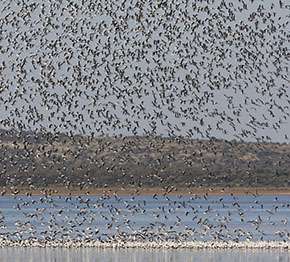Scientists track movements of desert waterbirds from space

Deakin University scientists have gained fascinating new insights into the secret lives of a nomadic Australian waterbird whose ability to somehow know it has rained up to thousands of kilometres away has intrigued researchers for generations.
The research team at Deakin's Centre for Integrative Ecology tracked the movements of 21 Banded Stilts using tiny solar-powered satellite tracking devices, watching them move to inland desert lakes including Lake Eyre and the Coorong at the mouth of the Murray River.
Deakin PhD student Recce Pedler said the results showed the extreme nomadic movement behaviour of the species, which is renowned for breeding in huge nesting colonies at desert salt lakes during rare flooding events.
"For many years we've known that they must fly long distances to get to these desert lakes after rain, but our satellite tracking work reveals that they can fly much further and faster than previously thought," Mr Pedler said.
"Banded Stilts are exquisitely adapted to the boom-bust cycles of the Australian desert. Of greatest fascination is the way that these and other waterbirds can somehow sense recent rainfall or flooding from thousands of kilometres away, then rapidly move there in response.
"Unlike other waterbird species, the Banded Stilts do not to breed near the coast. Instead, they move inland and form massive nesting colonies of thousands of pairs when salt lakes flood, feasting on brine shrimp that hatch from eggs which have lain dormant in the dry salt crust for years."
The research team, whose work has been published today in Biology Letters, tracked the movements of the 21 birds over an average of 196 days, uncovering extreme long-distance nomadic flights of hundreds of kilometres to and from desert salt lakes.
"These birds moved much further and faster than we had expected, including two that crossed from Lake Eyre in South Australia, to the Canning Stock Route in Western Australia in just a few days. Incredibly, one of these birds flew over 2,200 km in less than 2.5 days," Mr Pedler said.
"Twelve other stilts made rapid flights from inland salt lakes as they dried, rapidly covering hundreds of kilometres to return to important coastal refuge wetlands such as the Coorong, which sustain them during dry times.
"Their long distance flights across the Australian continent are longer and faster than those recorded in other desert waterbirds, yet we still don't understand how they know when it's time to move and where they should fly to."
Mr Pedler said the research had uncovered new questions which the CIE team hoped to answer through further studies, including how the stilts and other waterbirds know when to move inland following rain and what signals they use to sense that distant desert wetlands have been flooded.
"One explanation could be that they respond to changes in barometric pressure or distant thunder that could signal rain" he said.
"Or maybe they can smell the recently flooded wetlands on the wind from hundreds of kilometres away."
The researchers are now focussing on additional questions relating to the extreme movement, breeding behaviour and conservation needs of this species.
"We are also really interested to know how the birds time their flights in relation to weather conditions such as favourable wind direction and other variables," Mr Pedler said.
"We are keen to learn more about which inland wetlands are important for the stilts for breeding, but also which coastal saline wetlands provide refuges during droughts. These are important areas for the species' conservation."
Journal information: Biology Letters
Provided by Deakin University


















